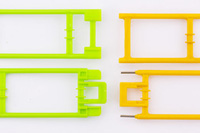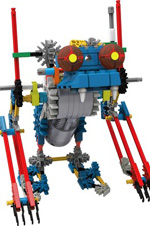K’Nex Brings Production Back From China
Daily News Article — Posted on March 12, 2013
(by James. R. Hagerty, The Wall Street Journal) HATFIELD, Pa. – …K’Nex Brands LP, a family-owned company in this Philadelphia suburb, is trying to prove toys can still be made in America.
Over the past few years, K’Nex has brought most of the production of its plastic building toys back to its factory in Hatfield from subcontractors in China. To make that possible, the company has redesigned some of the toys and even handed over to kids a bit of the assembly formerly performed by hand in China.
“In the long term, it’s much better for us to manufacture here,” says Joel Glickman, chairman of K’Nex and its manufacturing affiliate, Rodon Group. The two companies have combined sales of more than $100 million, making them small players compared with American rivals Hasbro and Mattel, neither of which has announced plans to shift production to the U.S.
By moving production closer to U.S. retailers, K’Nex said it can react faster to the fickle shifts in toy demand and deliver hot-selling items to stores faster. It also has greater control over quality and materials, often a crucial safety issue for toys. And as wages and transport costs rise in China, the advantages of producing there for the U.S. market are waning.
But K’Nex has found it impossible so far to produce 100% U.S.-made toys, the firm’s goal. The K’Nex experience shows both the attractions of “reshoring” production and the difficulties of making that happen in a country whose manufacturing infrastructure has atrophied.
Lining up suppliers has been a complicated chore in the U.S., where toy-making skills have faded. China, by contrast, has a vast, efficient network of suppliers and skilled labor. “In China, you can go over with just a drawing and say, ‘I need a million of these,'” says Michael Araten, chief executive of K’nex. That helps account for a huge U.S. deficit in the toy trade. In 2012, U.S. imports of toys, games and sporting goods, mostly from China, totaled $33.5 billion, or about three times U.S. exports of such items.
The roots of K’Nex go back to 1956, when Irving Glickman set up a small factory to make plastic items, such as protective caps for chair legs. In the early 1990s, his son, Joel, invented K’Nex toys to diversify the product line. By the late 1990s, K’Nex was following the fashion among U.S. companies of moving production to China. The affiliated Rodon company continued to make such items as plastic window parts and coffee filters, requiring little manual labor, at the Hatfield factory.
When the U.S. economy slumped in 2008, demand for products made by Rodon fell so sharply that the company couldn’t keep all its workers busy. To avoid major layoffs, the Glickman family decided to begin moving production of the K’Nex toys back to Hatfield.
The Glickmans were confident that Rodon, whose slogan is “Cheaper Than China,” could use its highly automated processes to mold plastic parts at a competitive cost. The challenge was that making K’Nex toys also involves manual labor, which is still much more costly in the U.S.

Yellow roller-coaster track parts, right, were made in China; Rodon Group made the green ones in the U.S
Toys had to be reimagined in some cases. K’Nex roller-coaster tracks were held together with metal pins, inserted by hand in China. The company redesigned the tracks so they could snap together. A tiny hubcap for K’Nex car wheels used to be attached by workers in a Chinese factory. Now it is included as a separate part in K’Nex kits, and children who get the toy have one more piece to snap into place.
Last year, K’Nex took over production and sales of Tinkertoys under license from Hasbro, which used to make them in China. Tinkertoys, a century-old product, were originally made of wood and later included both wood and plastic parts. To reduce costs and make U.S. production economical, K’nex last year switched to plastic for the remaining wooden spokes. K’nex adds that moms consider plastic easier to clean than wood.
K’nex also makes Lincoln Logs, likewise under license from Hasbro. It considered transforming them to plastic, but research showed the public wasn’t ready for plastic log cabins. So K’nex continues to have the logs made in China, though Mr. Araten hopes to find a U.S. furniture company to produce the tiny logs in America.
K’Nex still imports small battery-powered motors for its toys from China because it hasn’t found a competitive U.S. supplier. Also still imported from China is the head of an Angry Bird toy that requires a rubberized coating that would be expensive to replicate in the U.S.
To increase U.S. content, K’nex has had to make compromises. Joseph Smith, the chief development officer at K’nex, points to a little car with a shiny metallic finish that zips around on one of the company’s roller coasters. The car’s silvery finish is “a neat look,” Mr. Smith says, but the process used to apply the coating is “expensive, it’s dirty, and we can’t do it here, so we design it out of the product.” Instead of the shiny coating, K’nex may supply decals, to be applied by the cars’ owners. …
Copyright 2013 Dow Jones & Company, Inc. All Rights Reserved. Reprinted here for educational purposes only. Visit the website at wsj.com.
Questions
1. Why did Rodon owners begin moving production of K'Nex toys back to Hatfield, PA in 2008?
2. What has Rodon Group done to their K'Nex toys to enable the company to bring production back to the U.S. from China?
3. List two ways bringing production back to the U.S. benefits company control over the product.
4. a) Why did/do companies move their manufacturing to China?
b) How have the costs to companies recently changed?
5. What is one of the main challenges to toy companies looking to resume production in the U.S.?
6. Why does K'Nex still import some parts from China?
Background
From the wsj article:
- Total employment at K'Nex and Rodon has grown to about 200 people from 150 four years ago. Wages at the nonunion plant range from about $12 an hour for the least-skilled machine operators to more than twice that for some of the toy designers, machine menders and makers of molds for plastic parts.
- K'Nex recently bought a $30,000 Baxter robot from Rethink Robotics Inc., Boston. For now, Baxter is performing simple packaging tasks. Eventually, Mr. Araten hopes that more sophisticated versions of the robot will help K'Nex move more assembly work back to the U.S.

